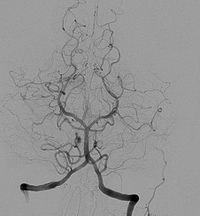
Photo from wikipedia
Background Intracranial atherosclerotic stenosis (ICAS) is one of the leading causes of ischemic stroke. Conventional anatomical analysis by CT angiography, MRI, or digital subtraction angiography can provide valuable information on… Click to show full abstract
Background Intracranial atherosclerotic stenosis (ICAS) is one of the leading causes of ischemic stroke. Conventional anatomical analysis by CT angiography, MRI, or digital subtraction angiography can provide valuable information on the anatomical changes of stenosis; however, they are not sufficient to accurately evaluate the hemodynamic severity of ICAS. The goal of this study was to assess the diagnostic performance of the pressure ratio across intracranial stenoses (termed as fractional flow (FF)) derived from cerebral angiography for the diagnosis of hemodynamically significant ICAS defined by pressure wire-derived FF. Methods This retrospective study represents a feasible and reliable method for calculating the FF from cerebral angiography (AccuFFicas). Patients (n=121) who had undergone wire-based measurement of FF and cerebral angiography were recruited. The accuracy of the computed pressure ratio was evaluated using wire-based FF as the reference standard. Results The mean value of wire-based FF was 0.78±0.19, while the computed AccuFFicas had an average value of 0.79±0.18. Good correlation (Pearson’s correlation coefficient r=0.92, P<0.001) between AccuFFicas and FF was observed. Bland–Altman analysis showed that the mean difference between AccuFFicas and FF was −0.01±0.07, indicating good agreement. The area under the curve (AUC) of AccuFFicas in predicting FF≤0.70, FF≤0.75, and FF≤0.80 was 0.984, 0.986, and 0.962, respectively. Conclusion Angiography-based FF computed from cerebral angiographic images could be an effective computational tool for evaluating the hemodynamic significance of ICAS.
Journal Title: Journal of NeuroInterventional Surgery
Year Published: 2023
Link to full text (if available)
Share on Social Media: Sign Up to like & get
recommendations!